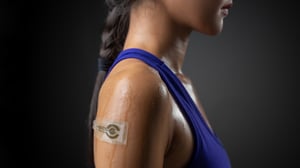Bioengineers at the Pennsylvania State University in the US have developed a cutting-edge device that uses microelectrodes made with nanoparticles. The device can measure various parameters, such as glucose levels, in an accurate and stable manner.
Sweat can provide valuable information about a person's state of health. For example, this ‘tool’ is already used when testing newborns who are suspected of having cystic fibrosis: the salt levels in their sweat are measured, and if they are above a certain threshold, the disease is diagnosed. However, it is near impossible to carry out these tests (also monitoring the levels of other substances in sweat throughout the whole day) in adults going about their usual day-to-day activities. While various kinds of wearable electrochemical sensors have been developed over time to achieve this, most have shown poor stability and specificity.
But these problems could now be overcome thanks to a device developed by bioengineers at the Pennsylvania State University (United States), who have integrated into a special patch a network of microelectrodes made with laser-modified graphene (carbon), gold and silver nanoparticles (remember that nanoparticles are around one millionth of a millimetre in size).
"Electrical" monitoring
As explained by the researchers in the scientific journal Advanced Functional Materials, the microelectrodes enable accurate measurement, first and foremost, of the levels of glucose (a molecule that is essential for metabolism) in sweat.
How does the device work? When glucose passes over the microelectrodes it undergoes oxidation, and this chemical reaction generates a current that is proportional to the amount of glucose present. The glucose concentration can therefore be determined indirectly by measuring the current. The patch can work for three weeks, simultaneously measuring sweat pH, which is normally slightly acidic. Incidentally, while a dramatic change in these values may indicate the presence of various illnesses, it is also true that acidity can rise following intense physical activity.
A non-invasive system
“Sweat is ideal for real-time, continuous and non-invasive biomarker detection,” said Huanyu ‘Larry’ Cheng, associate professor of engineering and mechanics at Pennsylvania State University and the lead author of the study. “But low biomarker concentration levels in sweat and variability of other factors such as pH, salinity and temperature have pushed previous sweat biosensors past the limits of their detection and accuracy. This device is able to account for this variability.” What is more, the new biosensor also ‘calibrates’ any fluctuations resulting from eating.
Roughly twice the width of a postage stamp, the patch is affixed to the skin with adhesive tape. It wirelessly transmits the data it has collected to a computer (or even a smartphone) for real-time monitoring and analysis.
The researchers pointed out that the new device is relatively low cost and may serve not only to help diagnose certain illnesses, but also to improve evaluation of the effects of drug treatments.




